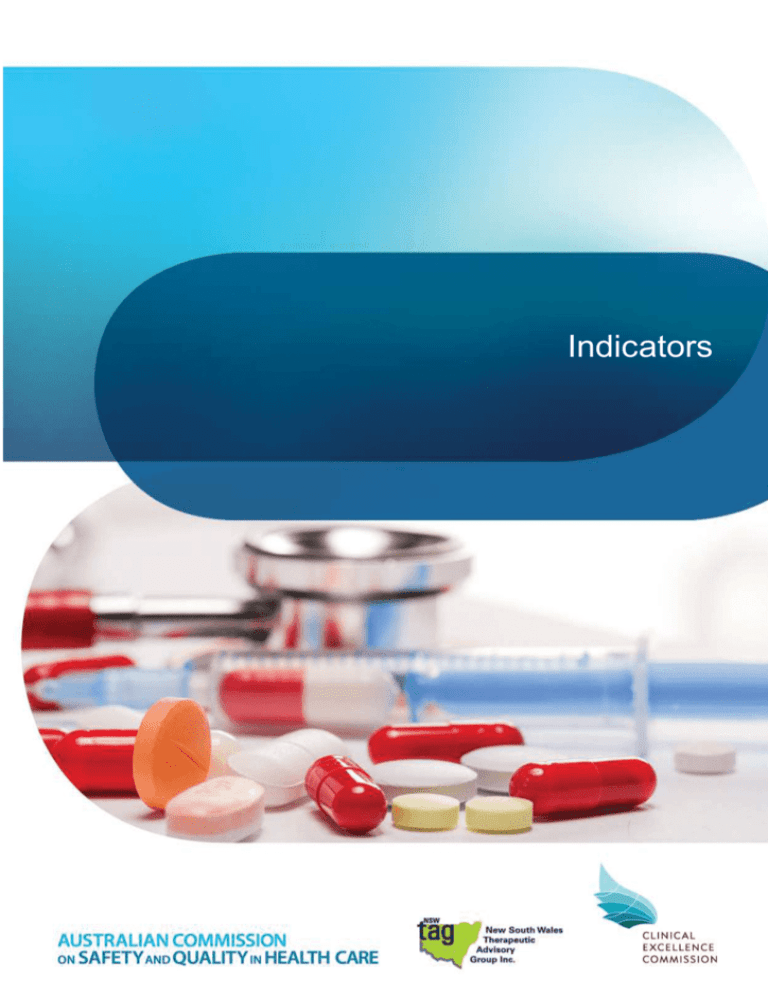WORD - Australian Commission on Safety and Quality in Health Care
advertisement

Indicators Continuity of care QUM domains: Judicious selection Safe and effective use 5.1 Percentage of patients with acute coronary syndrome that are prescribed appropriate medicines at discharge Purpose This indicator addresses the effectiveness of processes that promote appropriate pharmacotherapy for secondary prevention of acute coronary syndromes. Background and evidence There is high level evidence supporting the use of anti-platelet agents, angiotensin converting enzyme inhibitors (ACEIs) or angiotensin II receptor antagonists (ARAs), beta-blockers and statins for secondary prevention of coronary heart disease. 1-5 Indicators of appropriate management of acute coronary syndromes (ACS) have previously been used in Australian hospitals 6-8 and general practice. 9 Improving management of patients with ACS, including appropriate ongoing medication management, has been associated with reduced mortality. 2,10 However, despite widespread evidence, many patients admitted with ACS are not discharged on appropriate medicines. 6,11,12 Ensuring appropriate medication management after discharge is a guiding principle of the Australian Pharmaceutical Advisory Council Guiding Principles to Achieve Continuity in Medication Management. 13 This indicator provides a measure of compliance with these guidelines. Key definitions Acute coronary syndrome refers to the following groups of conditions: 1 ST-segment-elevation myocardial infarction (STEMI) Non-ST-segment-elevation acute coronary syndrome (NSTEACS) Unstable angina pectoris (UAP) If one or more of these medicine classes is not prescribed for the patient on discharge then the medication regimen can only be deemed as “appropriate” if there is a documented reason in the patient’s discharge summary for omission of that class of medicine, such as a contraindication, allergy or a documented plan to initiate that class of medicine in the future. Appropriate medicines means the patient is discharged on one (or more) of the medicines from each of the four classes of medicines shown in Table 1. 2,14,15 At discharge means there is documentation in the discharge summary or letter at time of transfer to community, residential care or other hospital that these medicines are to be taken on an ongoing basis. A supply of the medicines may or may not be dispensed by the hospital. Data collection for local use Please refer to the section Using the National Quality Use of Medicines Indicators for Australian Hospitals for guidance on sample selection, sample size, measurement frequency and other considerations. Inclusion criteria: Patients aged 18 years or over with a principle diagnosis of ACS. National Quality Use of Medicines Indicators for Australian Hospitals 2014 2 Exclusion criteria: Patients receiving clinical trial medicines, patients discharged against medical advice and patients receiving palliative/end of life care. Recommended data sources: Discharge referral documentation. The data collection tool for QUM Indicator 5.1 assists data collection and indicator ca lculation. Table 1. Appropriate medicines: medicine classes and examples Medicine class Examples of suitable medicines available in Australia Anti-platelet agents aspirin, clopidogrel, prasugrel, ticagrelor Beta-blockers atenolol, metoprolol, propranolol OR in patients with left ventricular systolic dysfunction: carvedilol, bisoprolol, metoprolol (controlled release), nebivolol ACEIs* captopril, enalapril, fosinopril, lisinopril, perindopril, quinapril, ramipril, trandolapril OR OR ARAs*, ** candesartan, eprosartan, irbesartan, losartan, olmesartan, telmisartan, valsartan Statins atorvastatin, fluvastatin, pravastatin, rosuvastatin, simvastatin * Not all agents have been studied in post-ACS patients. However the clinical effects of the agents within each medicine class are generally considered to be similar14 and ACS guidelines do not distinguish between specific ACEIs or specific ARAs. However there may be variations in approved (licensed) indications in Australia.1-5,14,15 ** Guidelines recommend use of ARAs in patients who are intolerant of ACEIs. 1-5 Data collection for inter-hospital comparison This indicator may be suitable for inter-hospital comparison. In this case, definitions, sampling methods and guidelines for audit and reporting need to be agreed in advance in consultation with the coordinating agency. Indicator calculation Numerator = Number of patients with ACS who are prescribed appropriate medicines at discharge Denominator = Number of patients with ACS in sample Limitations and interpretation This indicator looks at a bundle of care, not individual medicines. However it is recommended that individual components of the indicator are also collected to inform post-audit interventions. It may also be informative to look at data for each diagnosis separately (STEMI, NSTEACS or UAP). Evidence-based guidelines recognise the importance of dual anti-platelet therapy (DAPT) in the management of STEMI and NSTEACS patients, as well as patients who have received percutaneous co ronary intervention (PCI). 5-9 National Quality Use of Medicines Indicators for Australian Hospitals 2014 3 Consideration should be given to auditing the use of DAPT in these patient groups, as well as assessing documentation of the recommended duration of DAPT to ongoing care providers at discharge. The indicator does not take into consideration evidence-based dosing of the individual medicines. This indicator excludes patients with ACS who presented to the emergency department with UAP but were not admitted. Nevertheless, the need for appropriate ongoing medication management for these patients should not be neglected. Further information The Discharge Management of Acute Coronary Syndrome (DMACS) Toolkit published by NPS MedicineWise is a quality improvement tool to assist hospital staff to conduct audits of the discharge managem ent of patients with ACS. The toolkit, including audit tool and educational resources, is available at www.nps.org.au/healthprofessionals/cpd/activities/due-for-hospitals/discharge-management-of-acute-coronary-syndromes/dmacsdue/ Medication Safety Self Assessment for Australian Hospitals 16 (MSSA) can help identify potential strategies for improvement with this and other indicators. MSSA encourages development of robust systems for safe prescribing, dispensing, administration and monitoring of medicines. MSSA is available at www.cec.health.nsw.gov.au This indicator can be used to assist hospitals in meeting the National Safety and Quality Health Service Standard 1 [items 1.2.1, 1.2.2, 1.5.2, 1.6.1, 1.6.2, 1.7.2] and Standard 4 [items 4.1.2, 4.2.2, 4.5.1, 4.5.2, 4.12.4]. 17 References 1. Chew DP, Aroney CN, Aylward PE, et al. 2011 Addendum to the National Heart Foundation of Australia/Cardiac Society of Australia and New Zealand Guidelines for the Management of Acute Coronary Syndromes (ACS) 2006. Heart Lung Circ 2011; 20(8): 487-502. 2. National Heart Foundation of Australia and the Cardiac Society of Australia and New Zealand. Reducing Risk in Heart Disease: an Expert Guide to Clinical Practice for Secondary Prevention of Coronary Heart Disease. National Heart Foundation of Australia, 2012. 3. Smith SC, Benjamin EJ, Bonow RO, et al. AHA/ACCF Secondary Prevention and Risk Reduction Therapy for Patients with Coronary and Other Atherosclerotic Vascular Disease: 2011 Update. Circulation 2011; 124: 2458-2473. 4. European Society of Cardiology. ESC Guidelines for the Management of Acute Myocardial Infarction in Patients Presenting with ST-segment Elevation. Eur Heart J 2012; 33: 2569-2619. 5. European Society of Cardiology. ESC Guidelines for the Management of Acute Coronary Syndromes in Patients Presenting without Persistent ST-segment Elevation. Eur Heart J 2012; 33: 2999-3054. 6. Scott IA, Duke AB, Darwin IC, et al. Variations in indicated care of patients with acute coronary syndromes in Queensland hospitals. Med J Aust 2005; 182: 325-330. 7. Safer Systems Saving Lives: Improving Care for Myocardial Infarction Toolkit, version 4: Victorian Government Department of Human Services, 2006. 8. Ferry CT, Fitzpatrick MA, Long PW, et al. Towards a Safer Culture: Clinical Pathways in Acute Coronary Syndromes and Stroke. Med J Aust 2004; 180: S92S96. 9. Indicators of Quality Prescribing in Australian General Practice. National Prescribing Service Limited, 2006. 10. Bradley EH, Herrin J, Elbel B, et al. Hospital quality for acute myocardial infarction: correlation among process measures and relationship with short-term mortality. JAMA 2006; 296: 72-78. 11. Peterson ED, Roe MT, Mulgund J, et al. Association between hospital process performance and outcomes among patients with acute coronary syndromes. JAMA 2006; 295: 1912-1920. 12. Multicentre Drug Use Evaluation in Hospitals. Discharge Management of Acute Coronary Syndromes (DMACS) Project v1.0. National Prescribing Service Limited, 2010 13. Guiding Principles to Achieve Continuity in Medication Management. Australian Pharmaceutical Advisory Council, 2005. 14. Australian Medicines Handbook. Australian Medicines Handbook Pty Ltd, 2012. 15. eTG complete [Internet]. Melbourne: Therapeutic Guidelines Ltd; 2012 February. 16. Medication Safety Self Assessment for Australian Hospitals: Institute for Safe Medication Practices USA (Adapted for Australian use by NSW Therapeutic Advisory Group and the Clinical Excellence Commission), 2007. 17. Australian Commission on Safety and Quality in Health Care. National Safety and Quality Health Service Standards. Sydney, ACSQHC, 2012. National Quality Use of Medicines Indicators for Australian Hospitals 2014 4




